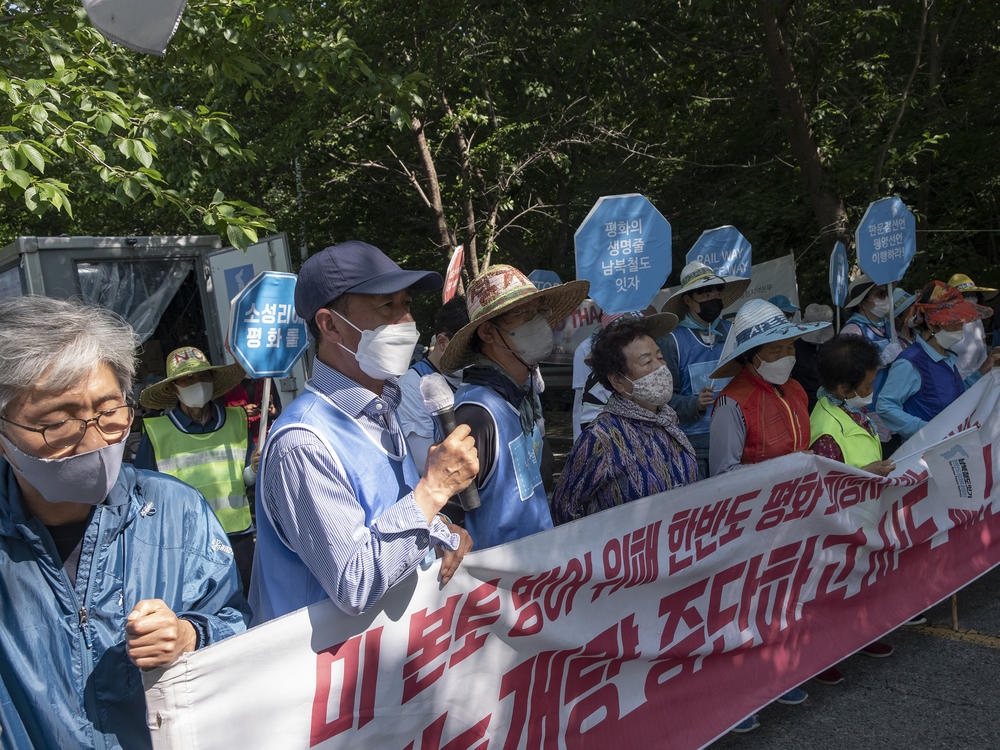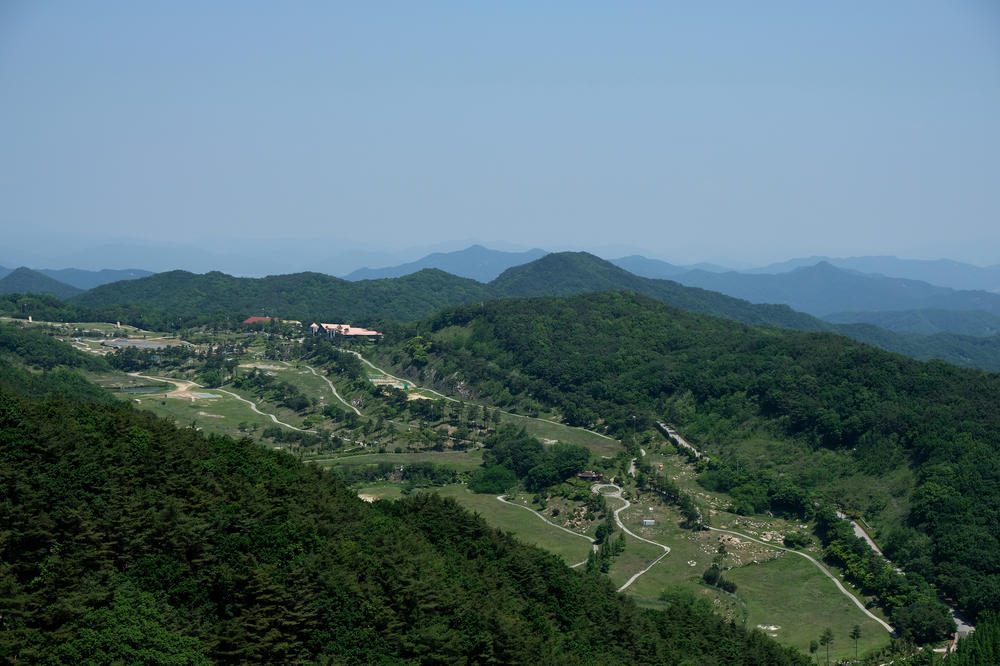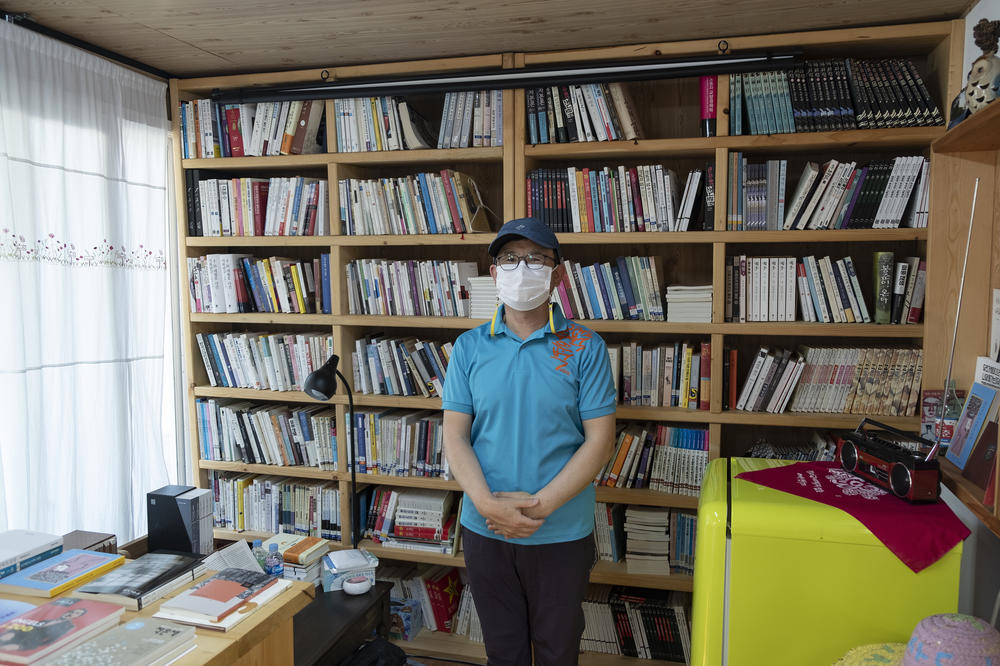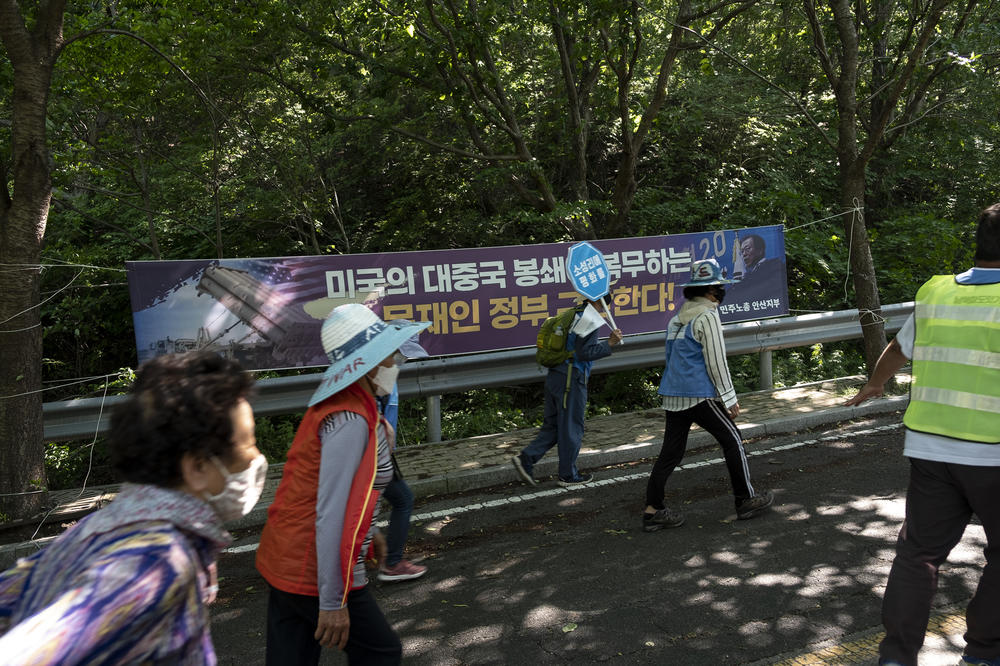Section Branding
Header Content
A South Korean village is protesting U.S. plans for THAAD missile defense upgrades
Primary Content
SOSEONG-RI, South Korea — A short hike in Seongju county, some 135 miles southeast of Seoul, brings you to the top of a small mountain. To the north, you can see the high-rises of Gumi city. Just in front of you lies a former golf course, with an old clubhouse, some shipping containers on the grass and six mobile missile launchers with their tubes pointing north, toward North Korea.
The launchers are part of the Terminal High Altitude Area Defense or THAAD system that the United States installed in 2017.
The base is a symptom of a growing arms race in Asia. The system is to defend against potential North Korean missiles, which have only in recent years been able to reach any part of the Korean Peninsula.
North Korea claims to have successfully test-launched its second hypersonic missile on Wednesday, intended to defeat missile defense systems including THAAD.
But opponents of the defense system argue it was installed without due democratic process and in disregard of their opinion on the matter.
"We activists and residents think that the THAAD deployment here is illegal," says activist Kim Young-jae. "So we try to stay alert and notice any changes happening inside the base."
In particular, they're looking for signs that the missile battery and living quarters for U.S. and South Korean troops are being upgraded.
After five years of operation, the place still looks a lot more like a golf course than a military base.
During a visit in March, Defense Secretary Lloyd Austin discussed with South Korean defense officials how the countries' soldiers were living in a golf clubhouse, with others in shipping containers, according to South Korean news reports.
Activists have blockaded the base to try to keep construction materials from getting in. The activist Kim says U.S. and South Korean authorities have not been straightforward about the base.
"Publicly, they say this is a temporary deployment, in order to deflect residents' opposition," he says. "But in fact, they've been taking every possible step to make it a permanent deployment."
THAAD is a symbol of South Korea's strategic predicament
On a geopolitical level, THAAD has become synonymous in South Korea with the country's delicate balancing act between its chief ally, the U.S., and its main trading partner and biggest neighbor, China. Beijing vehemently opposes the defense system, fearing that it could be used to defeat Chinese missiles or that its radar could spy on China.
For many South Koreans, THAAD brings to mind a cautionary tale of the economic punishment that China meted out on their country, when Seoul allowed the U.S. to deploy THAAD over Beijing's objections.
For the mostly elderly residents of Soseong-ri, a remote village of some 70 households close to the base, the prospect of upgrades to THAAD has been worrisome.
"This quiet village is now being ravaged," says resident Park Soo Gyu. "Some call it a jail without bars."
He notes that a dozen or so activists have faced prosecution, after clashing with police.
The residents also fear being caught in the crossfire between the U.S. and its potential foes.
"In case of a conflict between the U.S. and North Korea, or between the U.S. and China, this place will be the one of the first targets of attack," he says. "This village could become the front line overnight."
Protesters often gather near the base to chant slogans and call for the missile battery to be removed. A poster hanging near the entrance criticizes the administration of South Korean President Moon Jae-in, proclaiming: "We condemn the Moon Jae-in government for serving the U.S.' containment of China."
Is Seoul bound by its THAAD pledges to Beijing?
After the launchers were deployed to the golf course in 2017, Beijing used undeclared economic sanctions to punish South Korea, until Seoul made several promises. One was that it would not install any more THAAD batteries. Another was that the existing batteries in South Korea would not be integrated into the larger U.S. missile defense system.
But that's exactly what the Pentagon has in mind. Its Missile Defense Agency began testing in 2020 to link THAAD to its Patriot, or PAC-3, missile systems.
"I think the upgrades will involve, first and foremost, integrating the [THAAD] systems with other existing U.S. assets, obviously the PAC-3s," says Clint Work, a fellow with the Stimson Center, a think tank in Washington, D.C.
South Korea's Defense Ministry says personnel at the THAAD base should have adequate living quarters. As for the possible THAAD upgrade, the ministry has deferred to the U.S. on the issue.
"[The U.S.] has publicized a long-term plan [for upgrading THAAD], but it will take time to implement it," a ministry spokesman told reporters in 2020. "We are aware that the system in Seongju is scheduled to be updated, but we can't know in detail what's next."
Work believes that the idea is to give the U.S. and its bases multiple layers of defenses. "North Korea's own missile advancements clearly are intended to exploit gaps in the current coverage," he says.
Work says that the THAAD system here could also be integrated with other THAAD batteries in Japan and Guam, and a central missile defense control center in Alaska.
Could the system be redirected at China?
In future, the analyst says, it's possible that THAAD could be repurposed to counter a threat from China.
"At least as the U.S. currently states it, the way that the radar are oriented really doesn't allow too much peering into Chinese territory," Work notes. But, "they could easily be shifted to do so. And I wouldn't be surprised if they were."
Yoon Sukjoon, a retired Korean navy captain, argues that since THAAD is being integrated into U.S. missile defenses, Seoul is no longer constrained by its previous pledges to Beijing, and Washington doesn't need to beat around the bush about what THAAD is here for.
"Under the framework of competition with China, the U.S. no longer needs to make the excuse that that the system needs to be deployed on the peninsula solely for defense against North Korea," Yoon tells NPR.
He also argues that THAAD could mean the end of Seoul's strategic ambiguity about its relations with Beijing and Washington.
"THAAD is a part of the U.S.' global anti-China united front," Yoon says. "It's become a strategic tool for containing China from one of the closest countries and one of the most trustworthy allies of the U.S."
That's not the language of the outgoing President Moon's administration, which has avoided using any rhetoric about confronting Beijing.
The future of South Korea's approach to the THAAD issue could depend on the outcome of its presidential elections in March, with conservative and liberal candidates staking out opposing views on the topic.
NPR's Se Eun Gong contributed to this report.
Copyright 2022 NPR. To see more, visit https://www.npr.org.




